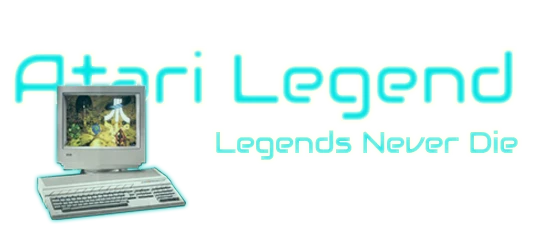

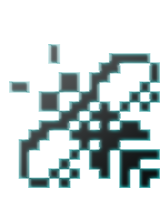





Frédéric Gérard was an Atari ST demo-scener who became a professional game programmer. He started his career at Titus in 1990, after he came 5th in the notorious Génération 4 demo competition. He is responsible for one of the absolute best arcade racers on the Atari ST, Crazy Cars 3. This interview takes us back to 1985, where it all started. From demoscene nostalgia to the development of an absolute classic.
There is currently no profile available in our database
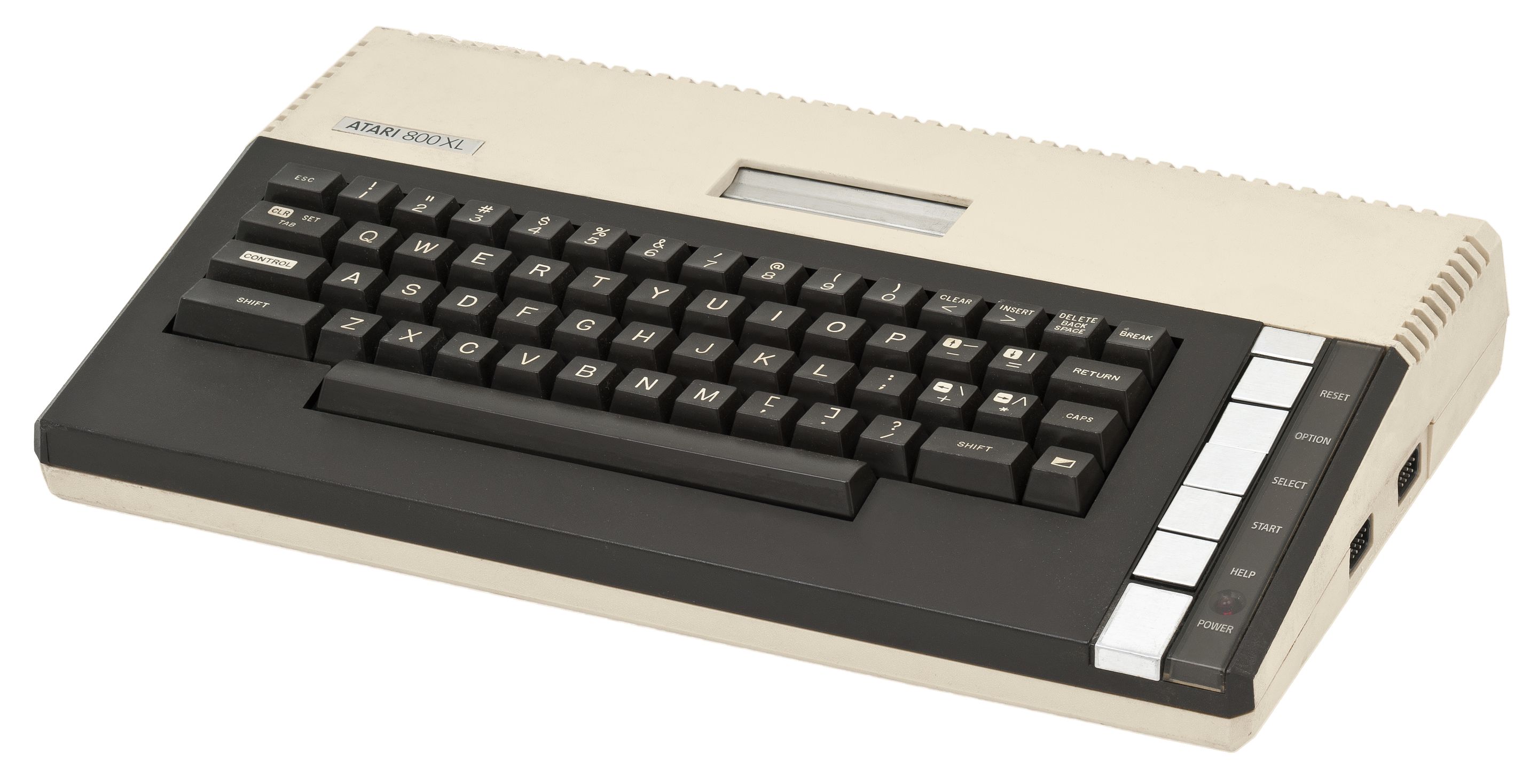
Before he had an ST, the 800XL was Gégé's main machine. He learned BASIC but never really completed a program or demo on it.
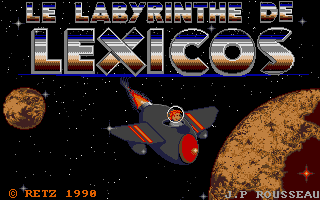
At Titus, Frédéric had to prove himself by converting educational games to the Atari ST and Amiga. The hardest part was quicly learning the C language on the way.
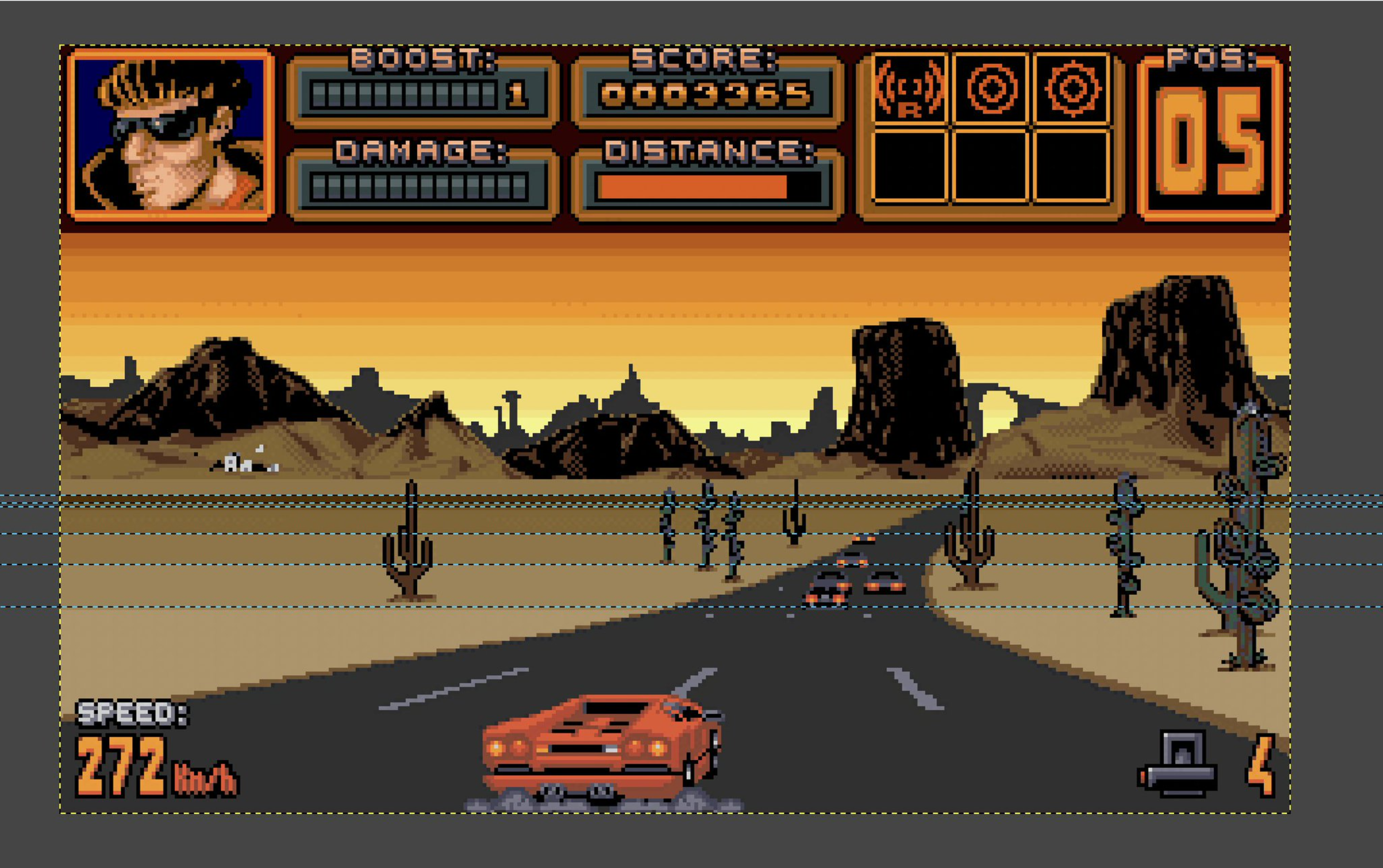
The gradient effect on the horizon and road was created using a technique involving HBL interrupts on the ST.
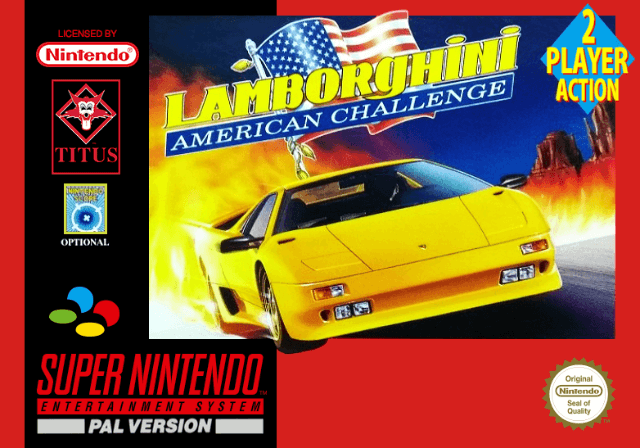
On the Super Nintendo, the game got rebranded to Lamborghini American Challenge and contained a split screen multiplayer mode.
1) I always start with the same question Frédéric. Can you introduce yourself in a few words to the people who have not heard from you?
I am passionate about everything I do. I like to challenge myself. As a child, I saw the first home computers appear. One day, a friend showed me these nice demos made by different coding crews and I knew that was what I wanted to do as well. Then I set myself the goal of becoming a video game programmer and I completed 9 games for the company Titus. After my departure from the games industry, I had the opportunity to learn how to operate trains. I started with freight trains, then passenger trains and now I conduct the international TGV for Thalys. My new passion is writing, I have already written several short stories and I have a novel in the works.
2) When exactly did you first see a computer, and which machine was it? And what did you do on it? Play games, program? Tell us a bit about your history with computers.
I started programming at the age of 15 on an Atari 800XL. At the time it was the BASIC language and the programs were recorded on audio tape.
3) And did you ever create anything on the 800XL? A finished demo or game or program?
No, it was my first machine and I did not yet have the coding skills to do anything, really. And it was also the year I lost my father to a heart attack.
4) We know you programmed Crazy Cars 3 on the Atari ST (more on that later), but have you ever owned an Atari ST? And when did Atari first appeared in your life? And if so, why the Atari ST (compared to for example the Amiga)?
The Amiga was my dream machine, but it was too expensive. At the age of 16, I worked during the summer school holidays to be able to buy myself an Atari 1040 ST. I remember at the time being impressed by the demos made by pirate crews (Union demo … ). I wanted to learn how to do the same. So I started programming in machine language to be able to optimize the routines as much as possible and push the limits of the Atari ST. My passion made me join a new coding group in Paris called Equinox. After 3 months, me and two other members quit the group and we created the TEC group. The goal was the exchange and sharing of knowledge, challenge each other and make more impressive demos. When I was part of TEC, I programmed two large demos, the TEC Demo and for a contest the GEN4 Demo. The GEN4 Demo later served as a gateway for me to apply as a programmer for Titus because it contained a mini shoot-em-up.
5) So you were a demo coder? Wow, that explains a lot. On Demozoo, you seem to have also made a cracktro for Shoot'em-Up Construction Kit. Do you remember this also?
No, it wasn't mine, I had already left the group to work at TITUS.
6) These demos are impressive. You are also credited for creating music. When I listen to the intro of the GEN4 demo, it features really nice digital music. Do you remember how you made it?
Yes, I had created it using a small homemade sound-tracker. I had also created a music file converter to turn the MIDI format (the standard for professional musicians) to a correct format for the mediocre YM sound processor of the Atari ST. It was used for Crazy Cars 3 as well.
7) Was the hidden shoot 'em up in the GEN4 demo the first game you ever created on the ST?
Yes, but after coding this demo, I had started a platform game on the Atari ST with two-level scrolling, the graphics for me were a copy of the Sonic game (because graphic design is not my thing). The game was to advance a ball that bounced permanently. You could inflate or deflate it, fill it with air, water, helium or even mercury to make it progress. I never finished coding this game because I started at Titus and had to program what I was asked to do. I had however showed it to them, but even though they were impressed by the scrolling, the game remained in the drawer.
8) We all know the wonderful Generation 4 magazine, which was a big thing in France, and also here in Belgium. But what was this competition exactly about? Do you remember anything about it and why you participated? Was it because you wanted to get a job as a programmer?
From what I remember, the first prize in the contest was an ATARI TT30 to be won and my demo ended up 5th place.
Correction : The first prize was an Archimedes.
9) You say it was a gateway to Titus. Please tell us all about this. And was Titus your first employer?
I sent a letter of motivation to Titus and I attached a disc of the GEN4 Demo. They invited me over and made me take programming tests and also answer a questionnaire. They were my first employer. Titus started by having me do five conversions of educational software for children. I converted these programs to the Amiga and Atari ST : Le labyrinthe de lexicos, Le labyrinthe d'anglomania, Le labyrinthe des pharaons… I used to program in assembler and to do this job, I had to quickly learn the C language.
10) You have done something very interesting in your career. You stopped working as a games programmer in the midst of the 90s and became a train operator. Why did you decide to quit the games industry?
I wanted to continue to program games but following the financial difficulties at Titus, I had to start a lawsuit to get paid for the work I had done. This led to my dismissal and this story left some resentment towards me from the management at Titus. After this event, the boss made sure the doors to other French video game companies would remain shut for me. That's the real reason. However, I like to always stay positive and leave the past behind, so I think a better version of the answer would be ... I wanted to spend my life driving at 300 km/h in magnificent scenery worthy of Crazy Cars 3. I leave you attached some photos that I sometimes do at work. (See next to this interview)
11) Let’s talk about Crazy Cars 3. What do you remember about the history of this project? How did it start? And how did this project end up in your hands?
One day Eric Caen (head of Titus and programmer) came to see me to ask if I knew how to create a scrolling road on the Atari ST. I worked at home and after a week I came up with a demo of road scrolling routine, based on HBL interrupts. When the team saw this demo, that is when we really started to define what the next installment in the series would look like. As a fan of arcade games, I took Outrun and Chase HQ as references. But it was Eric who validated the specifications. We had the idea of a system to earn money in the game, so you were able to buy parts and improve your car. I would have liked to program everything in assembler on the Atari ST to do something really optimized but in order to make quick conversions to other machines, I had to program parts of the game in the C language. The Amiga conversion was entrusted to a another programmer.
12) In our conversation on social media, you mentioned you programmed Crazy Cars 3 first on the Atari ST, and afterwards it was converted to the Amiga. This is so weird, as the Amiga clearly is the more capable machine and by 1991-92, games were mostly first made on the Amiga and then converted to the ST. Why was it decided to first make Crazy Cars 3 on the ST? Do you remember that? Was it your decision because you had so much experience on the ST as a demo coder?
The game progressed on both machines thanks to the C language. I took care of the main program and the optimization of the ST version routines (mainly written in assembler) and Richard Hooper took care of the specific routines for the Amiga and also programmed the betting system. So the game was actually coded on the ST and Amiga at the same time.
13) As a programmer, do you remember any of the difficulties you faced in making Crazy Cars 3? For example, what are you most proud of in the making of the game? What tools were used to program the game, and in what language was it done? Do you remember that?
The biggest difficulty was to keep the game more or less fluid. There were a lot of sprites to display: The cars in the first place, but also a lot of other scenery elements. In addition, they had to be sorted constantly to display them in the right order and sometimes some of them had to be hidden behind hills which were formed by the road. So there was a masking applied to them. It was very exciting to solve all the problems that we often discovered at the last moment. I also had to create a course editor written simply in BASIC on my Atari ST to generate small files defining the sequence of turns, slopes, ramps, color palettes, gradients, weather and background decorations. The graphic designers created mock-up images in Deluxe Paint on the Amiga and I retrieved the image to define the background images for the scrolling and the color palettes for the gradients. I'm quite proud to have succeeded in making a game that pushes the limits of the Atari ST a bit by displaying more colors than it is capable of (thanks to the HBL interrupt which allows you to define a new palette of 16 colors for each line of the screen). The road also uses the HBL technique. I had learned this technique when I was programming for the demo scene.
14) Did you work together with other people on this project? For example the graphics guys? And who were they? Do you perhaps remember anything from this part of the game? Like how the graphics were designed and the software that was used?
Coder : Richard Hooper/Rob Stevens (Amiga), Eric Caen (Additional Coder), Frédéric Gerard (me) (Atari ST and Super Nintendo)
Graphic Artist : Lyes Belaidouni, Francis Fournier, Didier Carrere
Music : Richard Hooper
15) Do you have any idea if the game sold well?
I think yes . Afterwards, there was a partner license with Lamborghini and console development on Super Nintendo.
16) Are you still in contact with former employees of Titus?
No
17) When I asked Alain Fernandes (programmer of the original Crazy Cars) about the licensing of the cars, he told me that in 1986, when the original game was released, none of the cars were licensed for the game, the car companies did not care about this. In Crazy Cars 3 you are clearly driving a Lamborghini Diablo. Was Lamborghini ever contacted and asked if Titus could use the car in their game? (The game even had a big poster with it of a yellow Diablo)
Yes, there was a partnership with Lamborghini which was created when making the Super Nintendo version. When the Atari ST and Amiga versions were completed, Titus received Super Nintendo development kits and gave me the technical documentation of the console to think about converting the game. We rewrote everything because on this console everything was done 100% in assembler and we could not re-use the program in C language. In addition, the console had dedicated coprocessors for sprites and scrollings. Everything had to be rewritten (Eric Caen and me, because Rob Stevens was working on the SNES version of Prehistoric Man). The work was long but in the end the game had evolved. Multiplayer with split screen. Once this version was advertised, the boss asked me to redo a multiplayer version for the Amiga. This version used the license and the game was published as Lamborghini American Challenge. I was going to try to convert it to the Atari ST (Difficult challenge) but I had already been entrusted with the task of adapting Prince Of Persia 2 on the Super Nintendo. I did that, and it ended up being the last game I ever programmed. I left the company when the PS1 and the Sega Saturn arrived.
18) Do you still program these days? Maybe as a hobby?
No, not really, but sometimes I help my daughter when she encounters difficulties at school with her programming exercises. So I recently learned the Python language to help her.
19) Are you still in anyway involved in the Atari scene?
No, after my departure, I looked what I could do with my life. I wanted to re-educate myself and do something completely different. I applied for different jobs but it was the SNCF that answered me first. After the aptitude tests, I had to have a rather difficult training for a year before I could conduct a train.
20) Are you a gamer? And is so, what is your favorite game, old or new?
On the other hand, yes, I remained a big child. I regularly play on consoles, PS4 at home and Switch on the go. I'm impressed and love single-player narrative games. My favorites are: The Last Of Us, Horizon, Uncharted, Red Dead Redemption and Dead Space.
21) If you could have a drink with anyone, dead or alive, who would it be and what would you ask him/her?
I would say my father, because he has not seen anything of the person I have become. I would like to know if he is proud of my journey and the family I have created with my adorable wife. I know this is impossible, so knowing that life can stop overnight, I try to leave good memories for my daughter. I would like to finish and publish a book for her. Prove to her that when you really want to accomplish something and you work for it, you end up getting there and leave a trace of my passage in this world.
22) Do you have any last words of wisdom to share with the Atari scene?
I would like to thank all the members of the coding groups that I met during the years 1985 - 1990, particularly TEC and the early members of Equinox. They made me evolve and they gave me support at a time in my life when I really needed it. I also thank Titus who gave me the chance of realizing my dream in becoming a video game programmer. And now I thank you Maarten for making me relive this glorious time dear to my heart and bringing me out of the shadows. For me, I was a programmer among many others. Bravo for your archive work which must take you a lot of time.
Thank you for everything Frédéric.
Check out the complete documentary of Frédéric and Crazy Cars 3 on Youtube.
Atari Legend : This interview was conducted in August of 2022. I was in the middle of writing the script for the Crazy Cars series of videos. I was also conducting an interview with Jean-Michel Masson. It has always been unclear who actually worked on the Amiga version of Crazy Cars 3. It was an English speaking programmer. According to Frédéric it was a man called Rob Stevens. Jean-Michel did not remember. I contacted Rob, and he only remembered playing a very small part in the development of Crazy Cars 3, if one at all. According to him it was Richard Hooper who did most of the work. I contacted Frédéric with this information and got some more memories from him, I would like to share with you all.
Frédéric : I joined Titus in July of 1990. I quickly met with Jean-Michel who was about to leave the company. I first did quick conversions of educational software. Each adaptation took a maximum of 1 month or sometimes even just 15 days. As it was my first job, I was poorly paid. After proving myself, I made an adaptation of the Dick Tracy game. However, I do not know very well if it was on the Amiga or the ST. Anyway, it had to go fast at Titus, no time to create super optimized routines, we had to use the code libraries they already used for their old games. I think at the time the finances were not very high. I continued with Crazy Cars 3, it was a big project but it was the same story, we had to go fast and indeed we went back to Crazy Cars 2 (made by Jean-Michel), it's on the Super Nintendo that I completely redid the road display routine using techniques learned during my time in the Atari ST scene. I also used my personal Atari to create the tools to precalculate the deformations of an image representing an upward-pointing triangle. This formed a semblance of a road on this console that didn't support 3D. It's my Atari that created all the courses on the SNES version. I finished the ST version in May of 1991 and left to do my military service in June 1991 (see photo).
I resumed my work in July 1992, the SNES having just been released in France. At that moment we all switched to this console. I was in charge of Lamborghini on this new console, Rob was working on Prehistoric Man and Vincent Berthelot on Super Cauldron. Another programmer Hervé Trisson worked on the Game Boy version of Crazy Cars 3. Eric Caen helped everyone by speeding up the programming of various useful routines. Once the console version was finished, the Crazy Cars 3 game had evolved, there was the Lamborghini license and above all a multiplayer mode. Eric asked me if I could add multiplayer mode quickly. I was able to do it on Amiga but unfortunately on Atari the game was unplayable because it was too slow. It would have taken time to optimize it as much as possible. But Titus was already giving me another job, converting Prince Of Persia 2 to the SNES in partnership with Psygnosis.
August 5, 2025 by grams88
Martin Brownlow is a living legend. Best known among ST fans for creating the beloved PD/shareware classics Grav and Grav 2, his games are still cherished by many to this day. From a young age, Martin knew he wanted to make games for a living...and he made that dream a reality. In fact, he’s still doing it today. Discover the full story and much more in this exciting new interview.
October 4, 2024 by grams88
Stacey Jamieson began his career at DMA Design, working on titles such as Oh No! More Lemmings, Walker, GTA and others. Over the years, he moved on to Electronic Arts (EA), where he contributed to major games like the Star Wars Battlefront series, Mass Effect, and Need for Speed. Today, he is the co-founder of Expression Games, where he continues to pursue his passion for game development. What an exciting career!
July 29, 2024 by grams88
Who doesn't love a good underdog story? Chris Sharp is a noteworthy apprentice of the renowned François Lionet, as he mastered the art of coding with the almighty STOS Basic. Chris crafted a few games for our cherished ST, including fan favourites like Magic Tomb and the Freaked Out series. Intrigued? Dive into our interview to revisit the era when game development could still be a solo endeavour.
July 16, 2024 by grams88
When Sega released its Master System, it came bundled with the game Alex Kid. To this day the game remains very popular, loved by many. One of those people is Terry Lloyd. More so, Alex Kid was the main inspiration for the Atari ST platform classic Axel's Magic Hammer. But that is just one of his many accomplishments. Terry has been around the block. Working as an artist and game designer at the beginning of the 80's for Gremlin Graphics, he then moved on to Core Design, which he helped get off the ground. During the 90's he contributed to founding the company Malibu Interactive. On the Atari ST, Terry's resumé include Dynamite Dux, Car-Vup, Rick Dangerous 1 & 2, Torvak the Warrior, WarZone and many more. Read all about this veteran of the games industry in this exciting interview.
April 18, 2024 by grams88
It doesn't always have to be about computers, coding and graphics. Adrian Powell, the artist behind the original Lemmings game, crafted all its artwork, including box art and promotional materials. His passion for painting lemmings has persisted over time and he is still painting lemmings to this day. Powell's work remains influential and has helped selling millions of copies of this classic (ST) game.
Currently 0 registered users online
In the past 24h there were 4 registered users online